26 Sep A Food Lover’s Guide to Azerbaijan: What to Eat
Food is one of the best aspects of Azerbaijan. If you don’t want to follow a busy schedule doing a gazillion things, you can actually just eat your way in Baku and Azerbaijan. Azerbaijani food is a blend of Turkic, Persian, Eastern European, and Caucasian influences and assimilates into a unique culinary identity.
With nine distinct climatic zones, Azerbaijan is blessed with a diverse range of produce—from lush fruit orchards to Caspian seafood, grains, dairy products, and tender livestock. At its heart are local cooking philosophies of seasonal bounty, self-sufficiency, and communal celebration.
Whether enjoyed in Baku’s modern caravanserai-inspired restaurants or in clay bowl–warmed village kitchens, Azerbaijani fare features saffron-laced rice, kebabs, dolma, cold salads, and the essential cup of black tea perpetually brewing in the background.
The Great Azerbaijani Breakfast
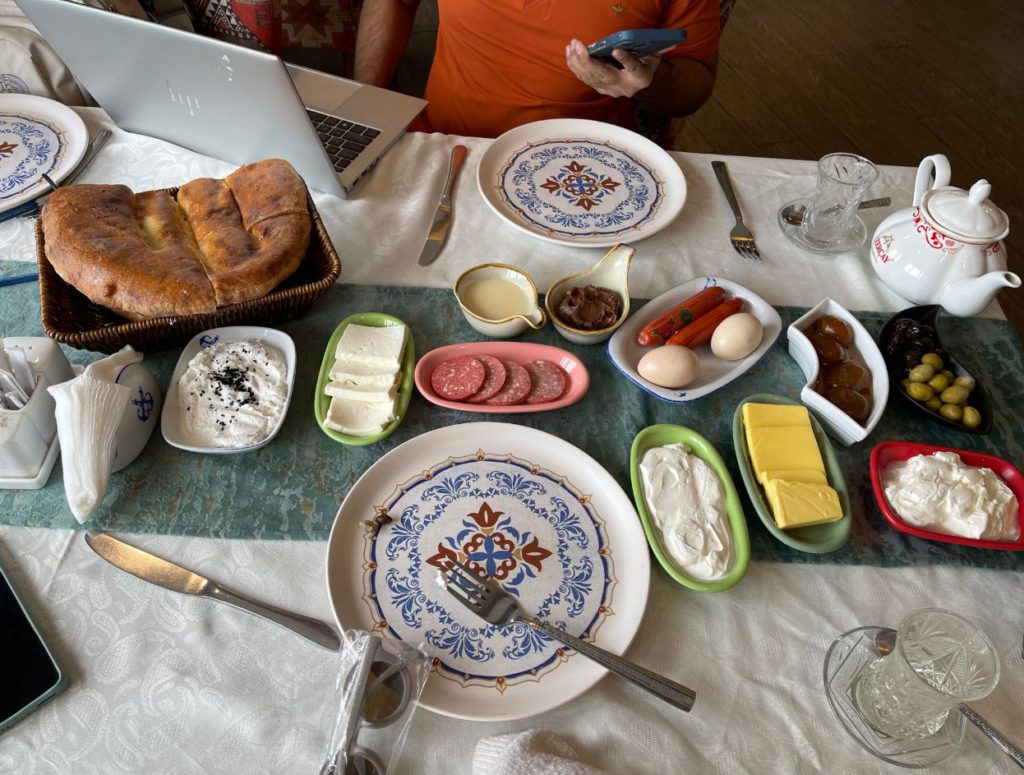
Of all things in Azerbaijan, you must sit for a lavish spread of the Azerbaijani breakfast. You don’t have to be a city cat for this, although restaurants in Baku offer some fantastic experiences. Even hotels and homestays in the countryside offer a delightful breakfast spread with freshly made items picked from the farmer’s markets or sometimes even from their own farmstead.
A typical breakfast consists of several cheeses. Some are freshly made, others are fermented and can range from cottage style to goat-reared feta. Other milk products include clotted cream, butter and sweetened condensed milk. These are paired with freshly baked, mouthwatering bread hot from the oven. There are cured meats, jams, honey or even chocolate to sweeten your bites.
Eggs are another important part of breakfast. Sometimes they are simply boiled or poached. Other times, they are done up with tomato (also called menemen in Turkey). You may also share your preference for this. Fresh fruits may complement the whole assortment if present in season. But you will always get a hot pot of tea to round it up.
Staying in Baku? Here are our suggestions on top neighbourhoods and hotels to stay in Baku
Food to try in Azerbaijan
For lunch or dinner, almost all restaurants offer ala-carte style menu and you can choose as per your preference. While the dishes are on the meaty side, if you are a vegetarian or a vegan, you will still be able to find something that you like. Most people are accommodating and can customise the food as per your requirements.
1. Pilaf
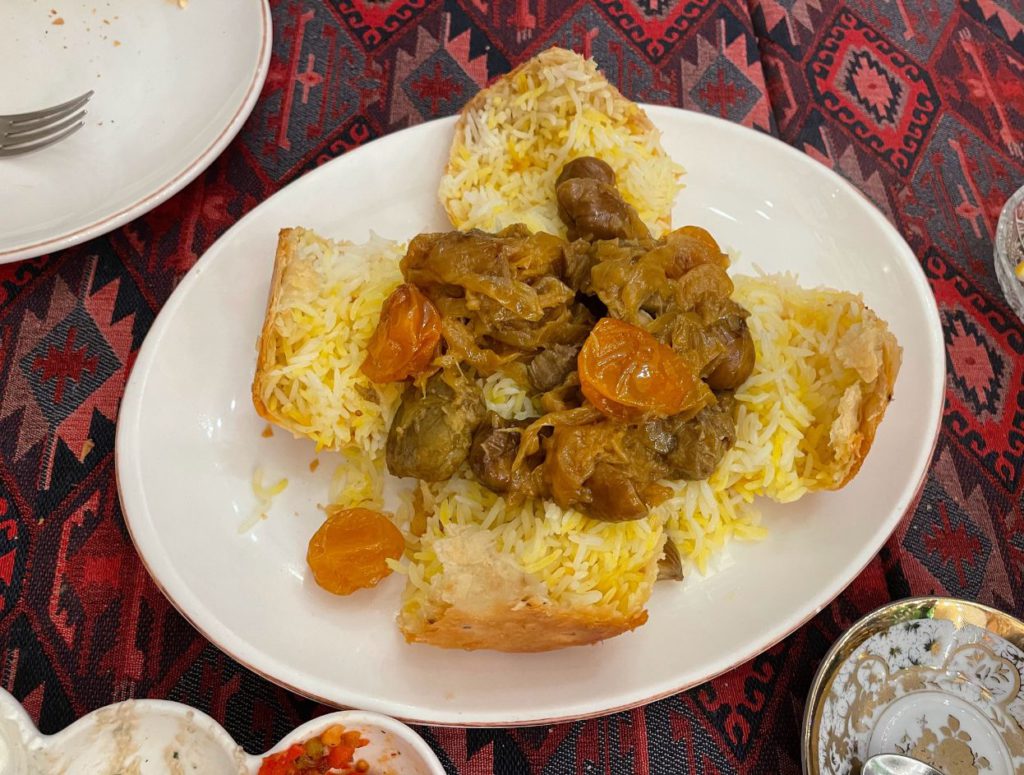
Pilaf, Plov or Pulao are all the same. But in Azerbaijan, Pilaf is considered a national treasure. It is not an everyday dish but is usually prepared during special occasions since rice is not as common as wheat or bread. But you can find it at most restaurants. There are several variants of Pilaf, ranging from simple vegetarian styles to ones filled with meat and nuts in the middle.
The pilaf is slow-cooked with whisked eggs, butter, saffron and spices in a container on low heat to form a golden crust of a slightly burnt layer on the outside. And this makes the star of the dish. You can try Chigtirma Pilaf with chicken in the centre or Parcha Doshamya Plov, which is greasy and heavy in calories. Shirin Pilaf is rich in aroma from cinnamon and rich with berries and nuts or Shah Pilaf, which hails from Ganja and looks like a golden pie with an outer layer of crust.
Enjoy pilaf with some meat cooked in gravy or with an appetiser like kebabs on the side and a drink.
2. Kebabs
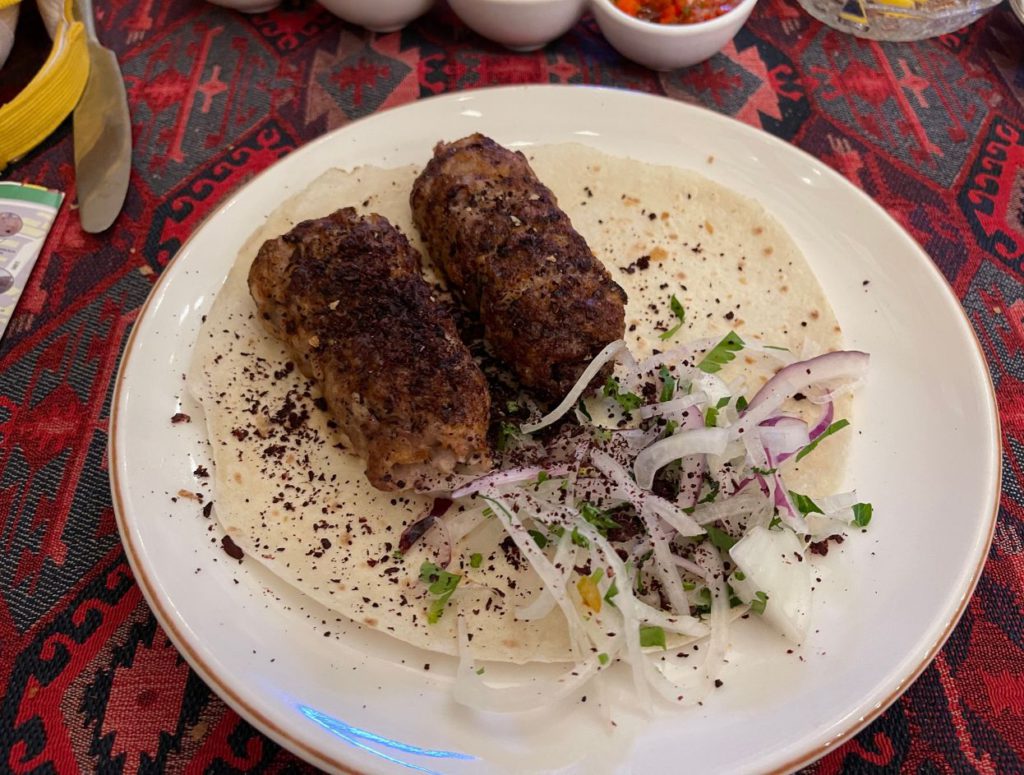
Kebabs are a universally loved food, not just in Azerbaijan but in almost all of Asia. The Azerbaijanis have their own version, locally called as Shishlik. Now kebabs can be made from chicken, lamb, beef, fish and even with vegetarian ingredients like eggplants (but may still contain animal fat).
I had lulu or lamb kebabs that came dripping in fat on top of fresh Azerbaijani bread with some pickles. A good kebab does not feel dry and is smoked to perfection. On the other hand, it can take some time to cook, so if you are in a hurry, check with the restaurant on the cook time.
3. Dolma

Dolma has been recognised by UNESCO as the country’s intangible cultural heritage. You should not miss the tasting culture in a roll. But again, Dolma is not exclusive to just Azerbaijan but can be found around the Caucasus region, the Middle East and the Mediterranean.
The concept is that grape leaves are stuffed with various kinds of stuffings ranging from meat, rice and vegetables cooked with aromatic spices. Some even have sweeter versions filled with nuts and raisins, and then braised cabbage leaves are used instead of grape leaves. So you will find different variations of Dolma depending upon where you are or even which household you are in.
Food Tours in Baku
4. Qutab
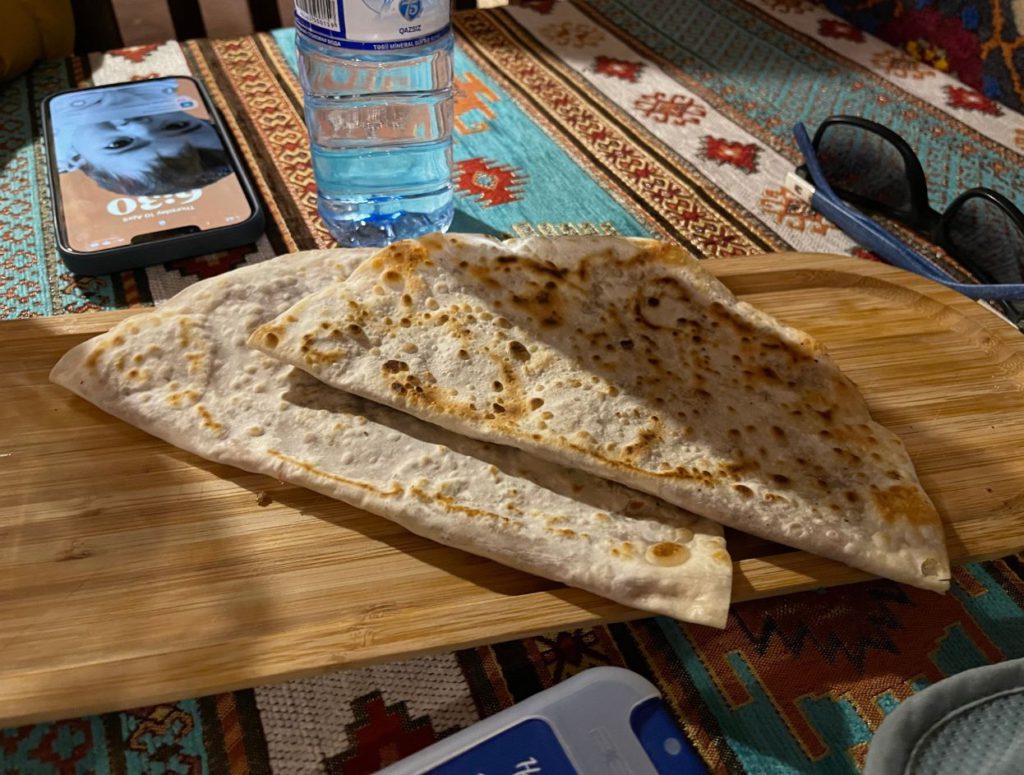
Qutab or Gutab is a stuffed flatbread that is hearty, filled and great for a snack, sometimes even on the go. Similar to other dishes, you can also find Qutab in Turkey and nearby regions. The one in the Nakhchivan region is made in rectangular shapes and baked in an oven.
In the mainland, Qutab is made with rolling thin dough of wheat and then stuffing it with different ingredients like some kind of meat, vegetables, cheese, pumpkin, onions, pomegranate seeds and herbs. It is then rolled back and cooked to brown in a traditional skillet. Butter or sumac is then added to the hot Qutab to make it even mouth-watering and delicious.
5. Bozbash
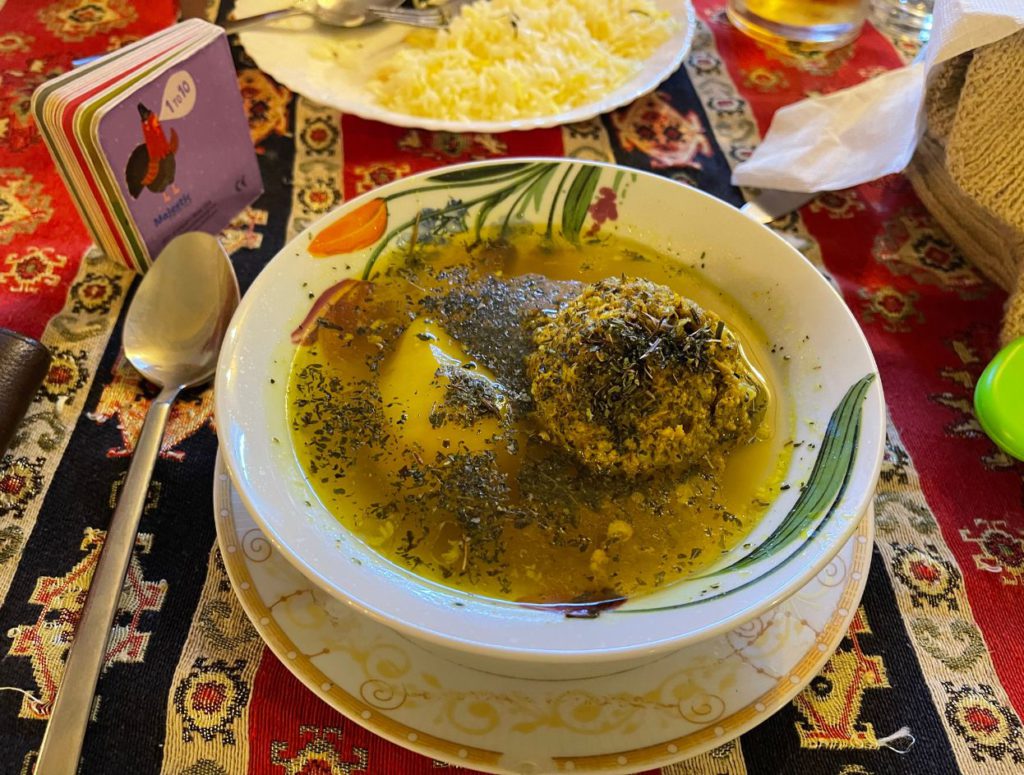
Bozbash is a hearty stew originating in Azerbaijan that is a popular comfort food for the locals. The soup or the stew is a transparent bowl of goodness cooked with spices, vegetables, potatoes, onions, chickpeas and dried fruit for some acidity. It tastes exactly how it looks, rich and a lot of warmth on a cold day.
The Parcha Bozbash is the vegetarian version of the stew. On the other hand, for the Kufta Bozbash, the star is usually a big ball of meat in the middle, at adds a lot of flavour and body to the stew. The most common meat is lamb, although beef and chicken are also common alternatives. It is served with a side of bread and sometimes pickled vegetables.
6. Piti
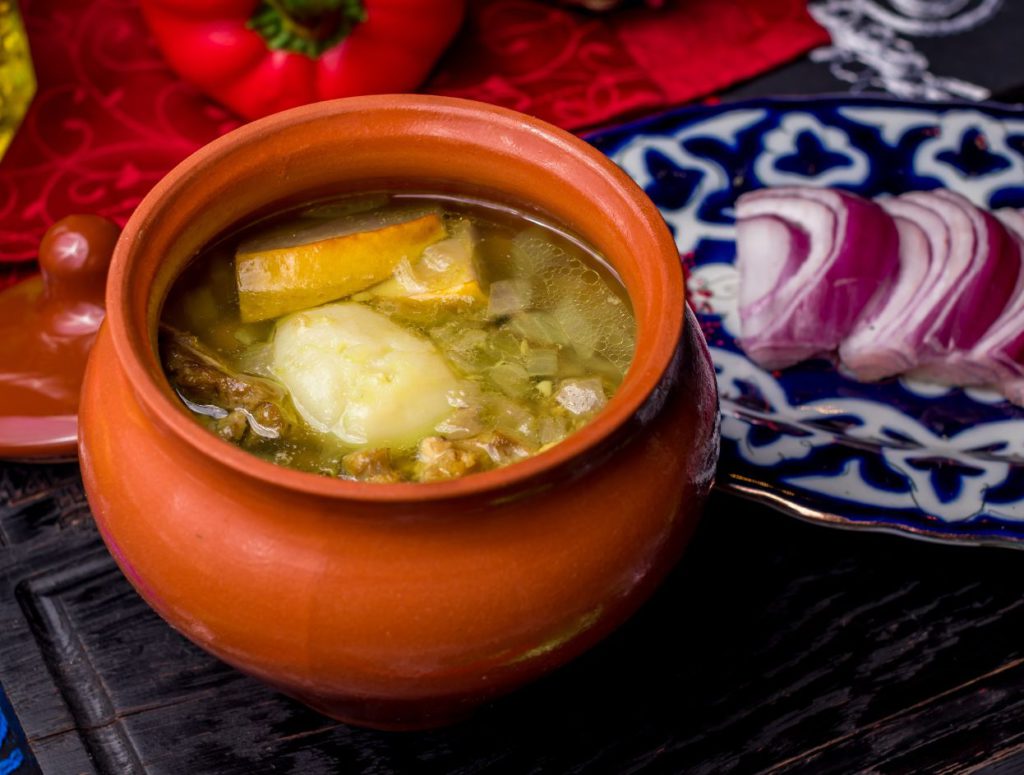
The origin of Piti dates all the way back to the Silk Road era around the Sheki region in Azerbaijan. It is also considered the national dish of Azerbaijan, but you can find a similar version in all of the Caucasus, especially in Armenia and Central Asia, where it is called Putuk, their local word for crock pot.
It is a traditional slow-cooked stew of lamb, chickpeas and other vegetables cooked in individual glazed claypots (dopu) in an oven for several hours. The stew becomes rich, unique in flavour from lamb tail fat, saffron, dried plum or quince.
Piti is eaten in two stages – First, you pour the broth over torn-up bread and eat it like soup. Then, you mash the meat and chickpeas with spices and enjoy them as the main dish. This makes eating Piti a unique experience.
Drooling over Sheki’s speciality? Read our guide on visiting Shamaki, Gabala and Sheki from Baku
7. Sadj
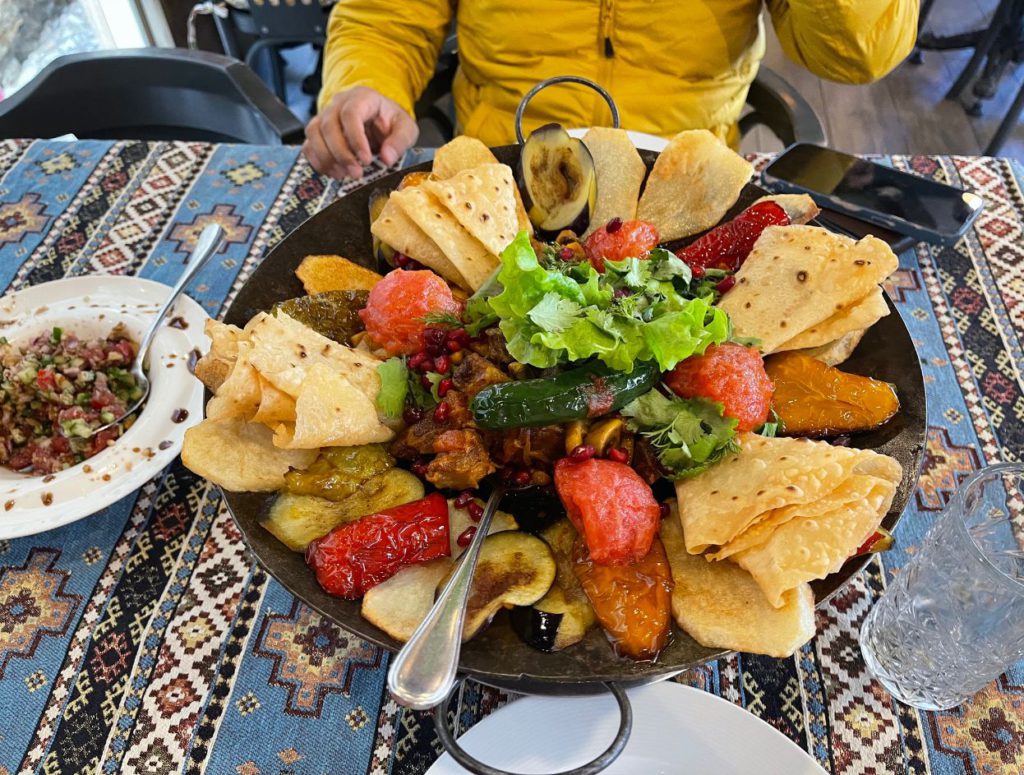
Food in Azerbaijan is often communal, with Sadj offering that warm experience for a gathering. Sadj is not a single dish but rather a way of cooking and serving food. Different seasoned ingredients are kept and grilled on a cast-iron pan with a burner to keep the pan continuously hot.
The ingredients can vary as per the restaurant, region or even season. It ranges from fresh vegetables like tomatoes, potatoes, peppers, eggplant and fritters on the side, while the middle part has more gravy with slow-cooked meat in rich aromatic onions and tomatoes with fatty oils. It comes with fresh bread that can be dipped in the gravy.
Eating Sadj is a social activity and is perfect for small and large groups where everyone can have their own pick and share.
8. Dovga
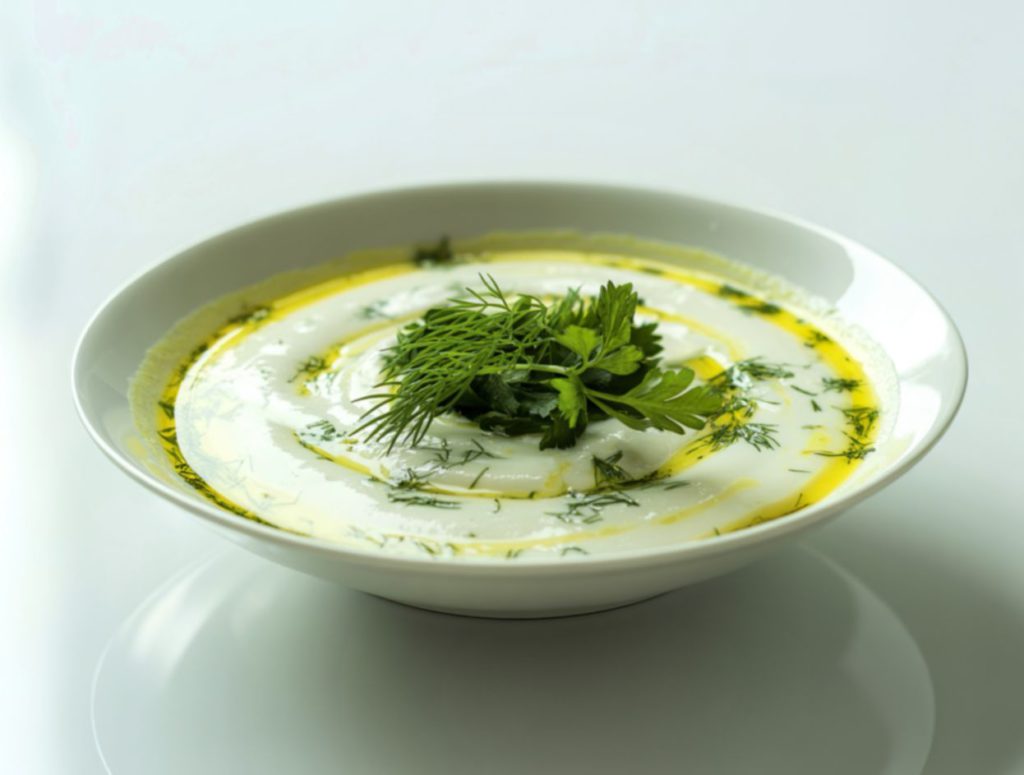
A Dovga is a refreshing traditional national soup that is creamy and herby with a balance of tangy and savoury notes. It is made of plain yoghurt, various fresh herbs (such as dill, mint, cilantro, sorrel), rice and sometimes chickpeas or meatballs. There are different versions of Dovga – it is often had with meat around Baku, while in Ganja, Dovga is often cooked vegetarian.
It can be enjoyed both warm and cold and making it suitable for all seasons. It is often served at Azerbaijani weddings and big feasts as starters or between meals to promote digestion. It can be had in a bowl or even in a glass like a drink. Some are even garnished with onions and garlic on top.
9. Dushbara

Like almost all cultures, Azerbaijan also have their version of the dumpling called Dushbara. Dushbara are tiny dumplings made with paper-thin dough and filled with different kinds of fillings such as lamb, onion, spices, vegetables or cheese. It is then cooked in a clear lamb broth to give it a soupy texture. The broth is flavoured with dried mint and garlic-vinegar sauce.
The key to a good Dushbara is to make them as small as possible. Traditionally, it should be small enough to fit ten to a dozen in a soup spoon. Making Dushbara is a labour of love often done by women sitting together, folding dough and chatting.
10. Buglama
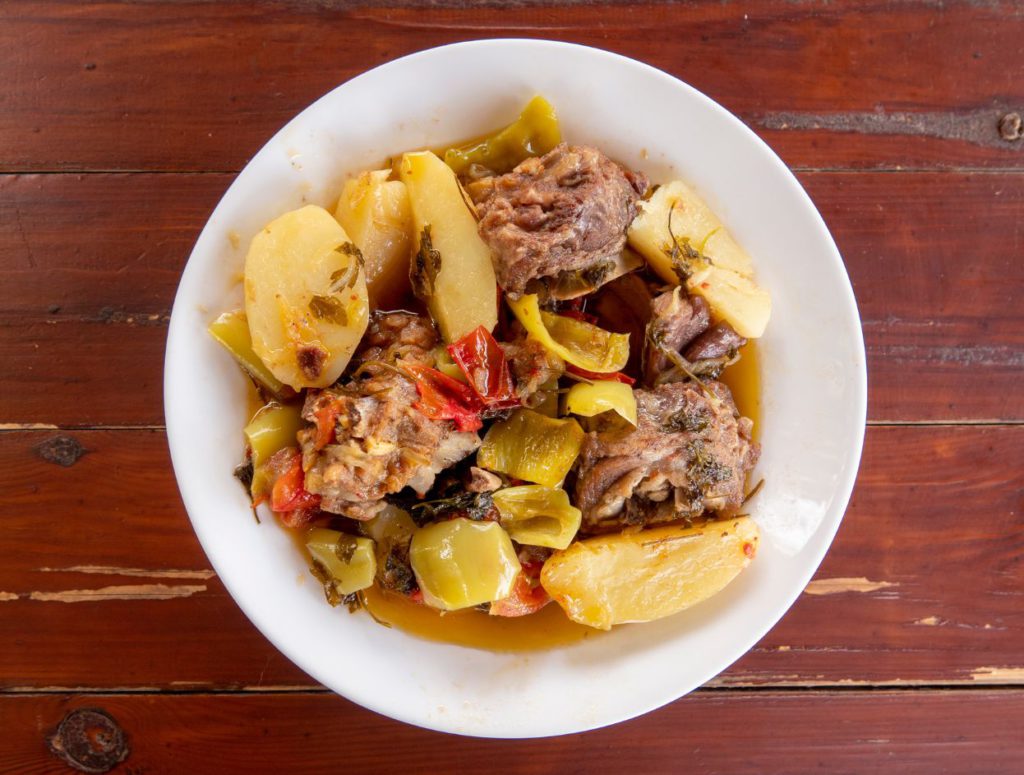
Buglama is another traditional dish popular in both Azerbaijan and Georgia. The dish is simple and is made with lamb, chicken or fish along with onions, tomatoes and peppers. All of this goes inside a clay pot with no water or sauce and is set to steam. A bit of salt, pepper and sometimes bay leaves are added to enhance the flavours. The purpose is to allow the meat to release its juices and cook in its own juices. This slow steaming makes the meat incredibly tender and aromatic.
Buglama is often enjoyed with a side of flatbread and some fresh green vegetables. It is a classic example of Azerbaijani cuisine, where only simple, high-grade, and fresh ingredients are used, enhancing the natural flavours. Buglama is also served with rice that is used to soak up all the gravy and flavours from the meat.
Dessert in Azerbaijan
1. Baklava
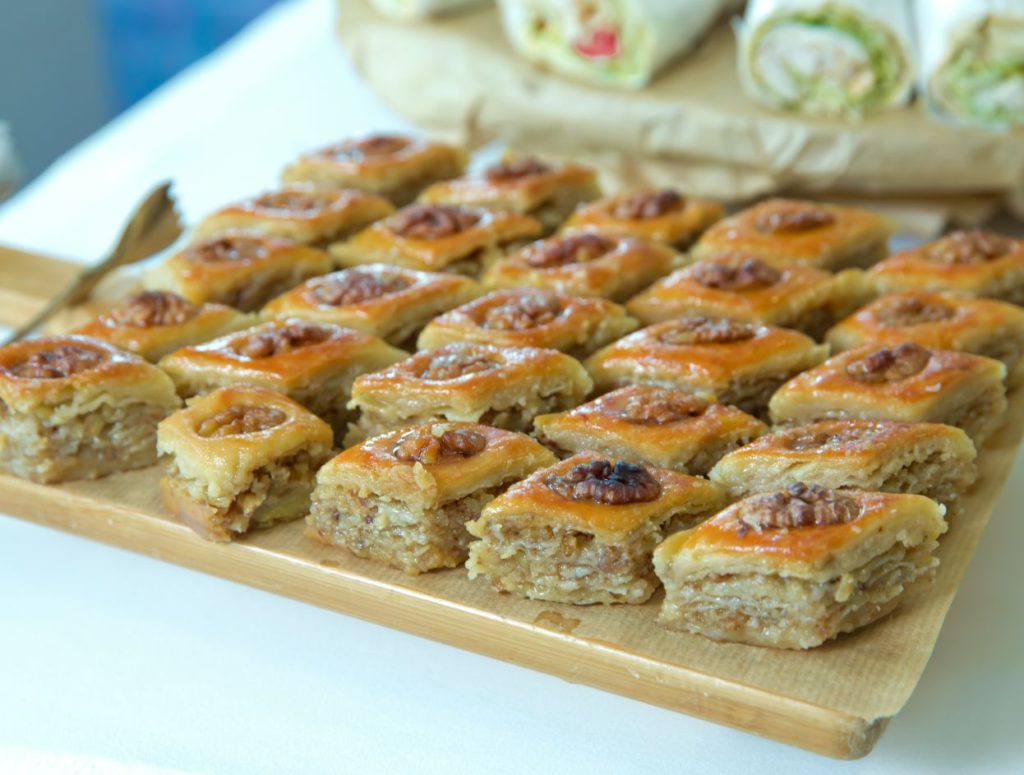
Nobody needs an introduction to Baklava. It has become world-famous. But if you have not tasted it yet, you must go ahead and find it, the first thing in Azerbaijan. It is often referred to as Pakhlava in some regions in Azerbaijan. It may be too sweet, though!
Baklava is made with several layers of Phyllo dough filled with chopped nuts of different kinds. It is then baked so that the outer crust becomes a delicious brown in colour and gives a crispy, flaky texture. Honey or a sweet aromatic syrup is added to it to induce the sweetness we are talking about. Baklava can come in several sizes, shapes and ingredients. The most common ones are made with pistachios, almonds and walnuts. But there may be ones with rose, chocolate or fruit flavours to add variety.
2. Shekerbura
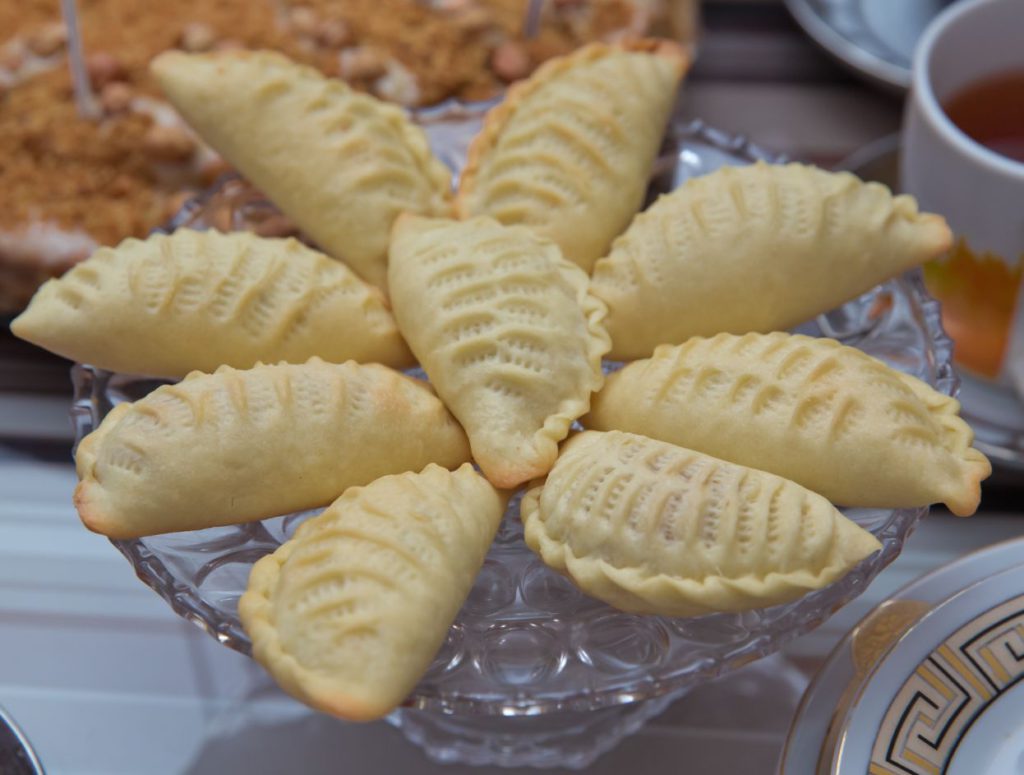
Shekerbura, or Shekarbur, is a sweet Azerbaijani pastry in a half-moon or crescent shape symbolising the moon. Their most distinguishing feature is the intricate, decorative patterns pressed onto the surface using a traditional pair of tweezers called maggash. If a maggash is not available, the pastries can be left plain and dusted with powdered sugar after baking. Shekerbus is an integral part of Nowruz, the Iranian or Parsi New Year, widely celebrated in Azerbaijan.
It is filled with ground nuts like almonds, walnuts, and hazelnuts mixed with sugar. The dough is made of wheat flour, butter, milk, egg yolks, cream, and yeast. The filling is prepared from peeled almonds or fried nuts mixed with sugar powder. It also includes cardamom to flavour the pastry. Since it is a seasonal dish, you may not find it easily during other times of the year.
3. Shirin Chorek
Shirin chorek is a traditional Azerbaijani sweet milk bread known for its soft, fluffy texture and golden-yellow colour. The name literally means “sweet bread” in Azerbaijani. While often enjoyed on its own with a cup of black tea, this sweet bread can also be used for sandwiches or even as a unique burger bun.
The preparation involves blooming the yeast, kneading a soft dough, and allowing it to rise twice to develop its light texture. After the final shaping and decorating, the bread is baked until golden. Historically, shirin chorek was a celebratory food baked for special occasions and holidays in Azerbaijan, particularly Nowruz (the New Year) and Ramadan. Today, it is widely available and eaten throughout the year, but its association with festivities remains.
Azerbaijani Tea
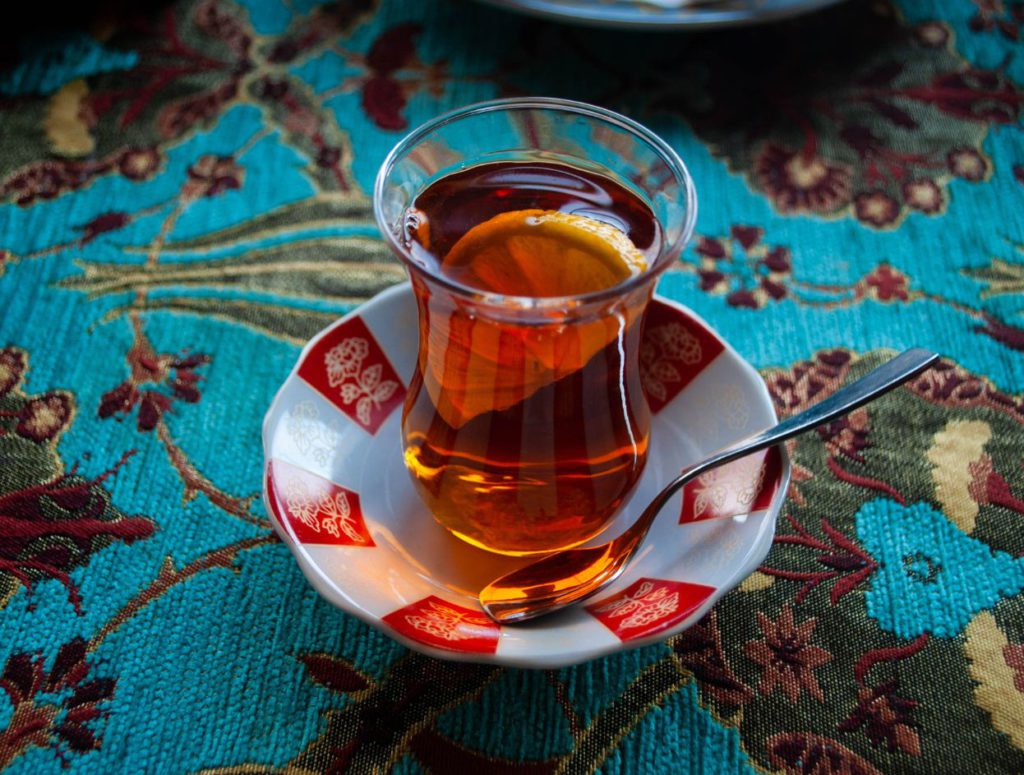
Azerbaijani tea culture, known as çay, is a deeply ingrained tradition symbolising hospitality, warmth, and social interaction. It is an essential daily ritual and plays a significant role in social events, from welcoming guests to finalising marriage agreements. The ritual of preparing and serving tea is as important as the drink itself, with its own specific tools and customs.
Tea is brewed using a samovar, a traditional metal container that heats the water and provides a distinctive, smoky aroma. Tea is traditionally served in a pear-shaped glass called an armudu. Instead of stirring sugar into the tea, Azerbaijanis practice a custom called dishleme. A sugar cube is first dipped into the tea, then bitten, and the tea is sipped through the sugar. This tradition dates back to medieval times when rulers, fearing poisoning, would test their tea by observing if a sugar cube caused a reaction.
The tea ceremony is accompanied by an array of “bites,” known as dishleme, which often include fruit preserves and jams. Common preserves are made from figs, strawberries, apricots, and walnuts. Various traditional pastries and sweets like pakhlava are also served.




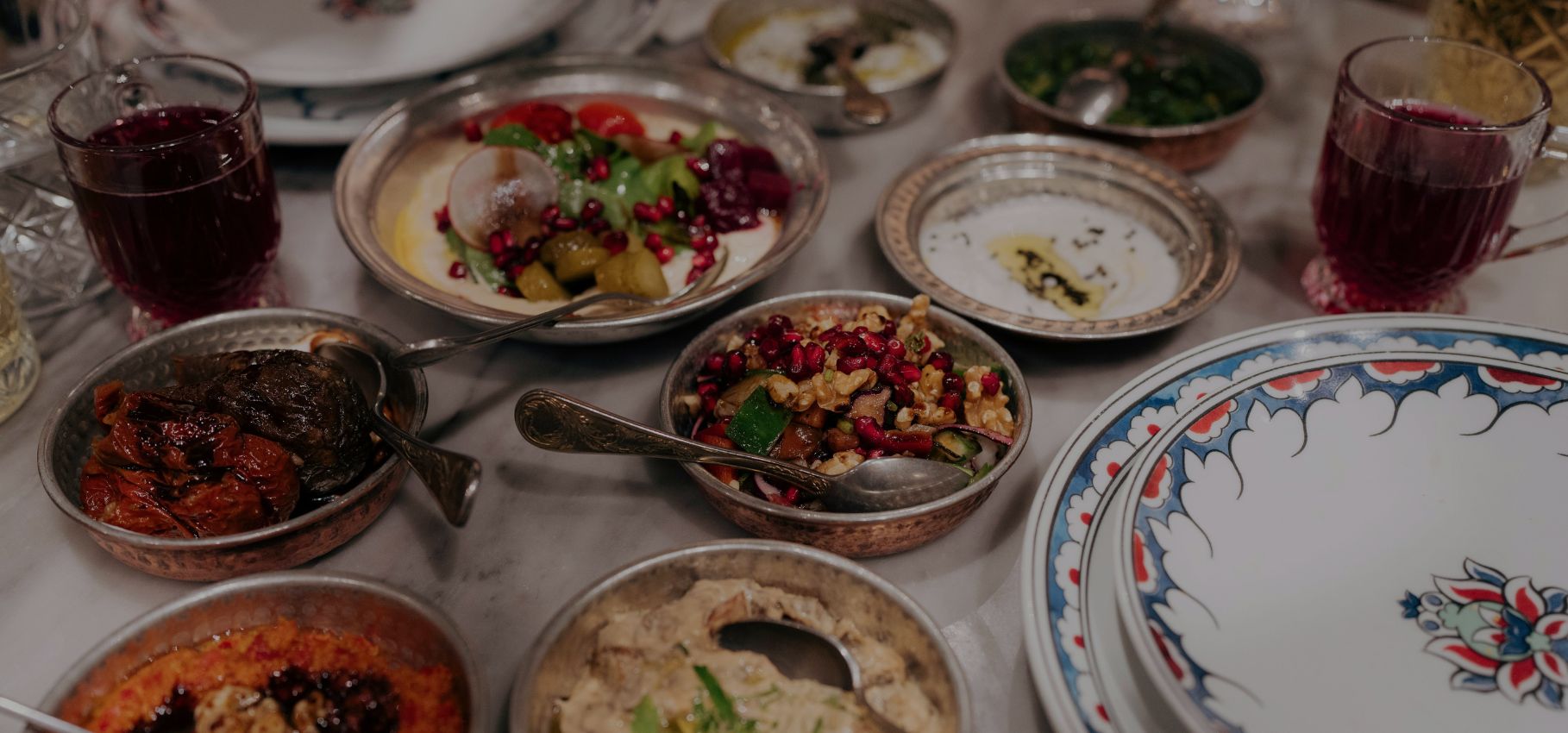
No Comments